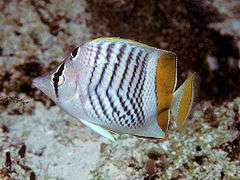Seychelles butterflyfish
The Seychelles butterflyfish (Chaetodon madagaskariensis) is a species of butterflyfish (family Chaetodontidae). It is found in the Indian Ocean from eastern Africa (as far south as Port Elizabeth in South Africa) east to Cocos-Keeling Islands and Christmas Island, north to Sri Lanka. The Seychelles butterflyfish is found in areas of rich coral growth on seaward reefs, at 10–40 m depth.[2]
| Seychelles butterflyfish | |
|---|---|
 | |
| Scientific classification | |
| Kingdom: | |
| Phylum: | |
| Class: | |
| Order: | |
| Family: | |
| Genus: | Chaetodon (but see text) |
| Subgenus: | Rhombochaetodon (disputed) |
| Species: | C. madagaskariensis |
| Binomial name | |
| Chaetodon madagaskariensis C. G. E. Ahl, 1923 | |
| Synonyms | |
|
Chaetodon madagascariensis (lapsus) | |
It grows to a maximum of 13 cm (more than 5 in) long. The body color is silver at the head, becoming white towards the tail, with a triangular orange patch covering the posterior and the caudal peduncle. There are a series of dark grey chevron lines on the sides of the body, partly broken into spots. Between the eyes and the start of the dorsal fin there is a black patch rimmed with white. The base of the caudal fin is white, followed by an orange patch and a white rim.[2]
Systematics
C. madagaskariensis is one of the "crowned" butterflyfishes. These form a group of largely allopatric species sharing the overall color pattern of dark forward-pointing chevrons on silvery hues, (usually) a black-and-white crown spot and yellow to red hindparts to a stunning degree; they differ in the exact combination of hues and some small pattern details. Other members of this lineage are the closely related Eritrean (C. paucifasciatus) and atoll butterflyfishes (C. mertensii), and the more distant pearlscale butterflyfish (C. xanthurus).[3][4]
The "crowned" Chaetodon are a clearly recognizable clade, but their further relationships are otherwise less clear. They were often placed in the subgenus Exornator, or considered a distinct subgenus Rhombochaetodon. According to various DNA sequence studies, some older and more singular lineages. These include species such as the Asian butterflyfish (C. argentatus), the blue-striped butterflyfish (C. fremblii) and Burgess' butterflyfish (C. burgessi). C. burgessi is in fact so peculiar that it was placed in a monotypic subgenus Roaops. But recognition of this would probably result in several other small or monotypic subgenera becoming justified, and the older Rhombochaetodon would be the more conveniently apply to the entire radiation.[3][4]
But the expanded group is of unclear relationships to species like the speckled butterflyfish (C. citrinellus) and the four-spotted butterflyfish (C. quadrimaculatus). These might be members of the subgenus Exornator – the lineages around the spot-banded butterflyfish (C. punctatofasciatus) – and C. citrinellus certainly looks somewhat similar to these. Yet phylogenetically, their position towards Rhombochaetodon is unresolved, and ultimately it might be better to merge both Rhombochaetodon and Roaops in Exornator. If the genus Chaetodon is split up, Exornator might become a subgenus of Lepidochaetodon or a separate genus.[3][4]
References
- Myers, R. & Pratchett, M. 2010. Chaetodon madagaskariensis. In: IUCN 2013. IUCN Red List of Threatened Species. Version 2013.1. www.iucnredlist.org. Downloaded on 10 September 2013.
- FishBase (2008): Chaetodon madagaskariensis. Version of 2008-JAN-14. Retrieved 2008-SEP-01.
- Fessler, Jennifer L. & Westneat, Mark W. (2007): Molecular phylogenetics of the butterflyfishes (Chaetodontidae): Taxonomy and biogeography of a global coral reef fish family. Mol. Phylogenet. Evol. 45(1): 50–68. doi:10.1016/j.ympev.2007.05.018 (HTML abstract)
- Hsu, Kui-Ching; Chen, Jeng-Ping & Shao, Kwang-Tsao (2007): Molecular phylogeny of Chaetodon (Teleostei: Chaetodontidae) in the Indo-West Pacific: evolution in geminate species pairs and species groups. Raffles Bulletin of Zoology Supplement 14: 77-86. PDF fulltext Archived 2007-08-11 at the Wayback Machine
External links
- Photos of Seychelles butterflyfish on Sealife Collection
